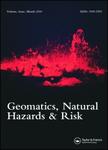版权所有:内蒙古大学图书馆 技术提供:维普资讯• 智图
内蒙古自治区呼和浩特市赛罕区大学西街235号 邮编: 010021

作者机构:Univ New South Wales Sch Civil & Environm Engn Sydney NSW Australia Australian Natl Univ Fenner Sch Environm & Soc Canberra ACT Australia Univ New South Wales Kirby Inst Biosecur Program Sydney NSW Australia
出 版 物:《GEOMATICS NATURAL HAZARDS & RISK》 (地球空间信息学、自然灾害与风险)
年 卷 期:2022年第13卷第1期
页 面:1867-1897页
核心收录:
学科分类:07[理学] 0708[理学-地球物理学] 0815[工学-水利工程] 0706[理学-大气科学] 0816[工学-测绘科学与技术]
基 金:Key Laboratory of Modern Acoustics Nanjing University
主 题:Fire severity classification burned area identification object-based image analysis Landsat 8 google earth engine
摘 要:In Australia, fire has become part of the natural ecosystem. Severe fires have devastated Australia s unique forest ecosystems due to the global climate change. In this study, we integrated a multi-resolution segmentation method and a hierarchical classification framework based on expert-based knowledge to classify the burned areas and land-uses in Kangaroo Island, South Australia. Using an object-based image classification framework that combines colour and shape features from input layers, we demonstrated that the objects segmented from the multi-source data lead to a higher accuracy in classification with an overall accuracy of 90.2% and a kappa coefficient of 85.2%. On the other hand, the single source data from post-fire Landsat-8 imagery showed an overall accuracy of 87.4% which is also statistically acceptable. According to our experiment results, more than 30.44% of the study area was burned during the 2019-2020 Black-Summer fire season in Australia. Among the burned areas, high severity accounted for 12.14%, moderate severity for 11.48%, while low severity was 6.82%. For unburned areas, farmland accounted for 45.52% of the study area, of which about one-third was affected by the disturbances other than fire. The remaining area consists of 19.42% unaffected forest, 3.48% building and bare land, and 1.14% water. The comparison analysis shows that our object-based image classification framework takes full advantage of the multi-source data and generates the edges of burned areas more clearly, which contributes to the improved fire management and control.